Effects of Size and Surface Properties of Nanodiamonds on the Immunogenicity of Plant-Based H5 Protein of A/H5N1 Virus in Mice
Abstract
1. Introduction
2. Materials and Methods
2.1. Nanodiamond Preparation
2.2. Production of Recombinant the H5.c2 Antigen
2.3. Conjugation of H5.c2 Antigen onto the Surface of Nanodiamonds
2.4. H5.c2:ND Conjugate Characterization
2.4.1. Hemagglutination Assay
2.4.2. Size and Zeta-Potential Measurements
2.4.3. SDS-PAGE and Western Blot of H5.c2-NDs
2.5. Mouse Experiment
2.6. ELISA
2.7. Detection of H5.c2-Specific-IgG Antibody Responses by Western Blot
2.8. Hemagglutination Inhibition Assay
2.9. Statistical Analysis
3. Results
3.1. Production and Biological Characterization of the H5.c2:ND Conjugates
3.2. Size and Surface Properties of the H5.c2: ND Conjugates
3.3. H5.c2:ND40 and H5.c2:ND100 Mixtures Stimulated Stronger H5.c2-Specific-IgG Antibody Responses in Comparison to the Free H5.c2 Protein
3.4. Stronger Neutralizing Antibody Responses Were Induced by the H5.c2:ND40 and H5.c2:ND100 Conjugates, as Opposed to the Free H5.c2 Protein
3.5. ND4 Does Not Have any Effect on the Immunogenicity of H5.c2 in Mice
4. Discussion
5. Conclusions
Supplementary Materials
Author Contributions
Funding
Institutional Review Board Statement
Informed Consent Statement
Data Availability Statement
Ethics Approval and Consent to Participate
Acknowledgments
Conflicts of Interest
References
- Lai, L.; Barnard, A.S. Functionalized nanodiamonds for biological and medical applications. J. Nanosci. Nanotechnol. 2015, 15, 989–999. [Google Scholar] [CrossRef]
- Gismondi, A.; Reina, G.; Orlanducci, S.; Mizzoni, F.; Gay, S.; Terranova, M.L.; Canini, A. Nanodiamonds coupled with plant bioactive metabolites: A nanotech approach for cancer therapy. Biomaterials 2015, 38, 22–35. [Google Scholar] [CrossRef]
- Mochalin, V.N.; Shenderova, O.; Ho, D.; Gogotsi, Y. The properties and applications of nanodiamonds. Nat. Nanotechnol. 2012, 7, 11–23. [Google Scholar] [CrossRef]
- Pham, M.D.; Yu, S.S.F.; Han, C.C.; Chan, S.I. Improved mass spectrometric analysis of membrane proteins based on rapid and versatile sample preparation on nanodiamond particles. Anal. Chem. 2013, 85, 6748–6755. [Google Scholar] [CrossRef] [PubMed]
- Passeri, D.; Rinaldi, F.; Ingallina, C.; Carafa, M.; Rossi, M.; Terranova, M.L.; Marianecci, C. Biomedical applications of nanodiamonds: An overview. J. Nanosci. Nanotechnol. 2015, 15, 972–988. [Google Scholar] [CrossRef]
- Hsiao, W.W.; Hui, Y.Y.; Tsai, P.C.; Chang, H.C. Fluorescent nanodiamond: A versatile tool for long-term cell tracking, super-resolution imaging, and nanoscale temperature sensing. Acc. Chem. Res. 2016, 49, 400–407. [Google Scholar] [CrossRef]
- Lim, D.G.; Prim, R.E.; Kim, K.H.; Kang, E.; Park, K.; Jeong, S.H. Combinatorial nanodiamond in pharmaceutical and biomedical applications. Int. J. Pharm. 2016, 514, 41–51. [Google Scholar] [CrossRef]
- Shenderova, O.A.; McGuire, G.E. Science and engineering of nanodiamond particle surfaces for biological applications (Review). Biointerphases 2015, 10, 030802. [Google Scholar] [CrossRef] [PubMed]
- Lin, C.L.; Lin, C.H.; Chang, H.C.; Su, M.C. Protein Attachment on Nanodiamonds. J. Phys. Chem. A 2015, 119, 7704–7711. [Google Scholar] [CrossRef]
- Xiang, S.D.; Scholzen, A.; Minigo, G.; David, C.; Apostolopoulos, V. Pathogen recognition and development of particulate vaccines: Does size matter? Methods 2006, 40, 1–9. [Google Scholar] [CrossRef] [PubMed]
- Zhao, L.; Seth, A.; Wibowo, N.; Zhao, C.X.; Mitter, N. Nanoparticle vaccines. Vaccine 2014 32, 327–337. [CrossRef]
- Kong, X.L.; Huang, L.C.L.; Hsu, C.M.; Chen, W.H.; Han, C.C.; Chang, H.C. High-affinity capture of proteins by diamond nanoparticles for mass spectrometric analysis. Anal. Chem. 2005, 77, 259–265. [Google Scholar] [CrossRef]
- Pham, M.D.; Wen, T.C.; Li, H.C.; Hsieh, P.H.; Chen, Y.R.; Chang, H.C.; Han, C.C. Streamlined membrane proteome preparation for shotgun proteomics analysis with triton X100 cloud point extraction and nanodiamond solid phase extraction. Materials 2016, 9, 385. [Google Scholar] [CrossRef] [PubMed]
- Pham, N.B.; Ho, T.T.; Nguyen, G.T.; Le, T.T.; Le, N.T.; Chang, H.C.; Pham, M.D.; Conrad, U.; Chu, H.H. Nanodiamond enhances immune responses in mice against recombinant HA/H7N9 protein. J. Nanobiotechnol. 2017, 15, 69. [Google Scholar] [CrossRef] [PubMed][Green Version]
- Yen, H.L.; Webster, R.G. Pandemic influenza as a current threat. Curr. Top. Microbiol. Immunol. 2009, 333, 3–24. [Google Scholar] [CrossRef] [PubMed]
- Han, T.; Sui, J.; Bennett, A.S.; Liddington, R.C.; Donis, R.O.; Zhu, Q.; Marasco, W.A. Fine epitope mapping of monoclonal antibodies against hemagglutinin of a highly pathogenic H5N1 influenza virus using yeast surface display. Biochem. Biophys. Res. Commun. 2011, 409, 253–259. [Google Scholar] [CrossRef] [PubMed]
- Thi Pham, V.; Thi Ho, T.; Trong Phan, H.; Le, T.H.; Bich Pham, N.; Conrad, U.; Huyen Vu, T.; Hoang Chu, H. A Plant-Based Artificial Haemagglutinin (A/H5N1) Strongly Induced Neutralizing Immune Responses in Mice. Appl. Sci. 2019, 9, 4605. [Google Scholar] [CrossRef]
- Office International des Epizooties (OIE). Avian Influenza (Infection with Avian Influenza Viruses). In Manual of Diagnostic Tests and Vaccines for Terrestrial Animals; World Organization for Animal Health: Cham, Switzerland, 2019; Chapter 3.3.4; pp. 830–831. Available online: http://www.oie.int/en/international-standardsetting/terrestrial-manual/access-online/ (accessed on 5 May 2020).
- Gahrtz, M.; Conrad, U. Immunomodulation of plant function by in vitro selected single-chain Fv intrabodies. Methods Mol. Biol. 2009, 483, 289–312. [Google Scholar] [PubMed]
- Hoang, H.T.T.; Nguyen, C.H.; Nguyen, N.T.T.; Pham, A.D.; Nguyen, H.T.T.; Le, T.H.; Tran, H.X.; Chu, H.H.; Nguyen, N.T. Immunization with the H5N1 recombinant vaccine candidate induces high protection in chickens against Vietnamese highly pathogenic avian influenza virus strains. Vaccines 2020, 8, 159. [Google Scholar] [CrossRef]
- D’Aoust, M.A.; Couture, M.M.J.; Charland, N.; Trépanier, S.; Landry, N.; Ors, F.; Vézina, L.P. The production of hemagglutinin-based virus-like particles in plants: A rapid, efficient and safe response to pandemic influenza. Plant Biotechnol. J. 2010, 8, 607–619. [Google Scholar] [CrossRef] [PubMed]
- Giles, B.M.; Bissel, S.J.; Dealmeida, D.R.; Wiley, C.A.; Ross, T.M. Breadth and protective efficacy are increased by vaccination with computationally optimized hemagglutinin but not with polyvalent hemagglutinin-based H5N1 Virus-Like Particle Vaccines. Clin. Vaccine Immunol. 2012, 19, 128–139. [Google Scholar] [CrossRef] [PubMed]
- Carter, D.M.; Darby, C.A.; Lefoley, B.C.; Crevar, C.J.; Alefantis, T.; Oomen, R.; Anderson, S.F.; Strugnell, T.; Cortés-Garcia, G.; Vogel, T.U.; et al. Design and characterization of a computationally optimized broadly reactive hemagglutinin vaccine for H1N1 influenza viruses. J. Virol. 2016, 90, 4720–4734. [Google Scholar] [CrossRef] [PubMed]
- Chen, H.W.; Huang, C.Y.; Lin, S.Y.; Fang, Z.S.; Hsu, C.H.; Lin, J.C.; Chen, Y.I.; Yao, B.Y.; Hu, C.M. Synthetic virus-like particles prepared via protein corona formation enable effective vaccination in an avian model of coronavirus infection. Biomaterials 2016, 106, 111–118. [Google Scholar] [CrossRef] [PubMed]
- Phan, H.T.; Ho, T.T.; Chu, H.H.; Vu, T.H.; Gresch, U.; Conrad, U. Neutralizing immune responses induced by oligomeric H5N1-hemagglutinins from plants. Vet. Res. 2017, 48, 53. [Google Scholar] [CrossRef] [PubMed][Green Version]
- Phan, H.T.; Pham, V.T.; Ho, T.T.; Pham, N.B.; Chu, H.H.; Vu, T.H.; Abdelwhab, E.M.; Scheibner, D.; Mettenleiter, T.C.; Hanh, T.X.; et al. Immunization with plant-derived multimeric H5 hemagglutinins protect chicken against highly pathogenic avian influenza virus H5N1. Vaccines 2020, 8, 593. [Google Scholar] [CrossRef]
- Garcia-Bennett, A.E.; Everest-Dass, A.; Moroni, I.; Rastogi, I.D.; Parker, L.M.; Packer, N.H.; Brownb, L.J. Influence of surface chemistry on the formation of a protein corona on nanodiamonds. J. Mater. Chem. B 2019, 7, 3383–3389. [Google Scholar] [CrossRef]
- Schirmbeck, R.; Melber, K.; Reimann, J. Hepatitis B virus small surface antigen particles are processed in a novel endosomal pathway for major histocompatibility complex class I-restricted epitope presentation. Eur. J. Immunol. 1995, 25, 1063–1070. [Google Scholar] [CrossRef]
- Liu, Y.; Sun, K. Protein functionalized nanodiamond arrays. Nanoscale Res. Lett. 2010, 5, 1045–1050. [Google Scholar] [CrossRef]
- Pham, M.D.; Epperla, C.P.; Hsieh, C.L.; Chang, W.; Chang, H.C. Glycosaminoglycans-specific cell targeting and imaging using fluorescent nanodiamonds coated with viral envelope proteins. Anal. Chem. 2017, 89, 6527–6534. [Google Scholar] [CrossRef]
- Barone, F.C.; Marcinkiewicz, C.; Li, J.; Sternberg, M.; Lelkes, P.I.; Dikin, D.A.; Bergold, P.J.; Gerstenhaber, J.A.; Feuerstein, G. Pilot study on biocompatibility of fluorescent nanodiamond-(NV)-Z~800 particles in rats: Safety, pharmacokinetics, and bio-distribution (part III). Int. J. Nanomed. 2018, 13, 5449–5468. [Google Scholar] [CrossRef]
- Rojas, S.; Gispert, J.D.; Martín, R.; Abad, S.; Menchón, C.; Pareto, D.; Víctor, V.M.; Alvaro, M.; García, H.; Herance, J.R. Biodistribution of amino-functionalized diamond nanoparticles. In vivo studies based on 18F radionuclide emission. ACS Nano 2011, 5, 5552–5559. [Google Scholar] [CrossRef] [PubMed]
- Vaijayanthimala, V.; Cheng, P.Y.; Yeh, S.H.; Liu, K.K.; Hsiao, C.H.; Chao, J.I.; Chang, H.C. The long-term stability and biocompatibility of fluorescent nanodiamond as an in vivo contrast agent. Biomaterials 2012, 33, 7794–7802. [Google Scholar] [CrossRef] [PubMed]
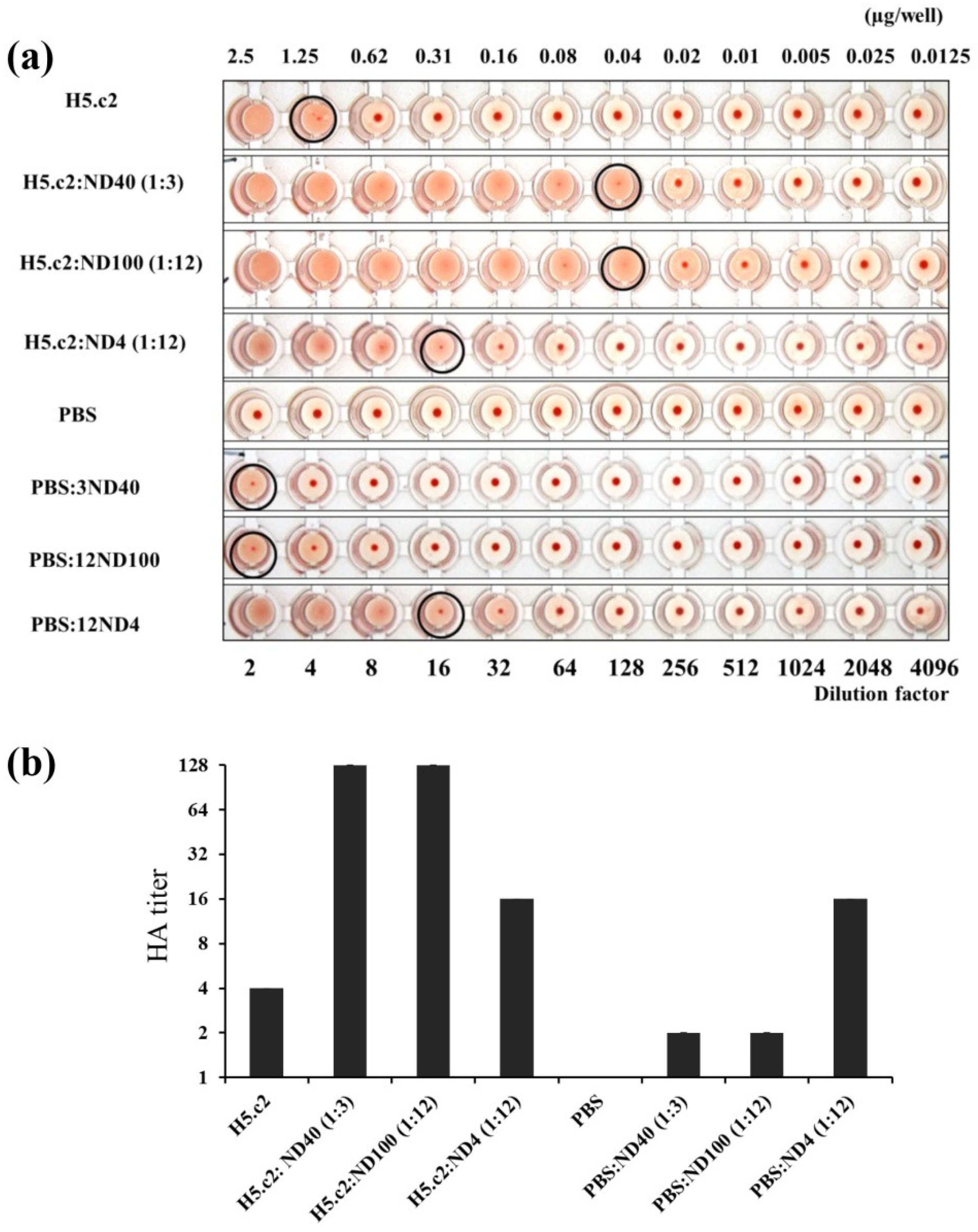
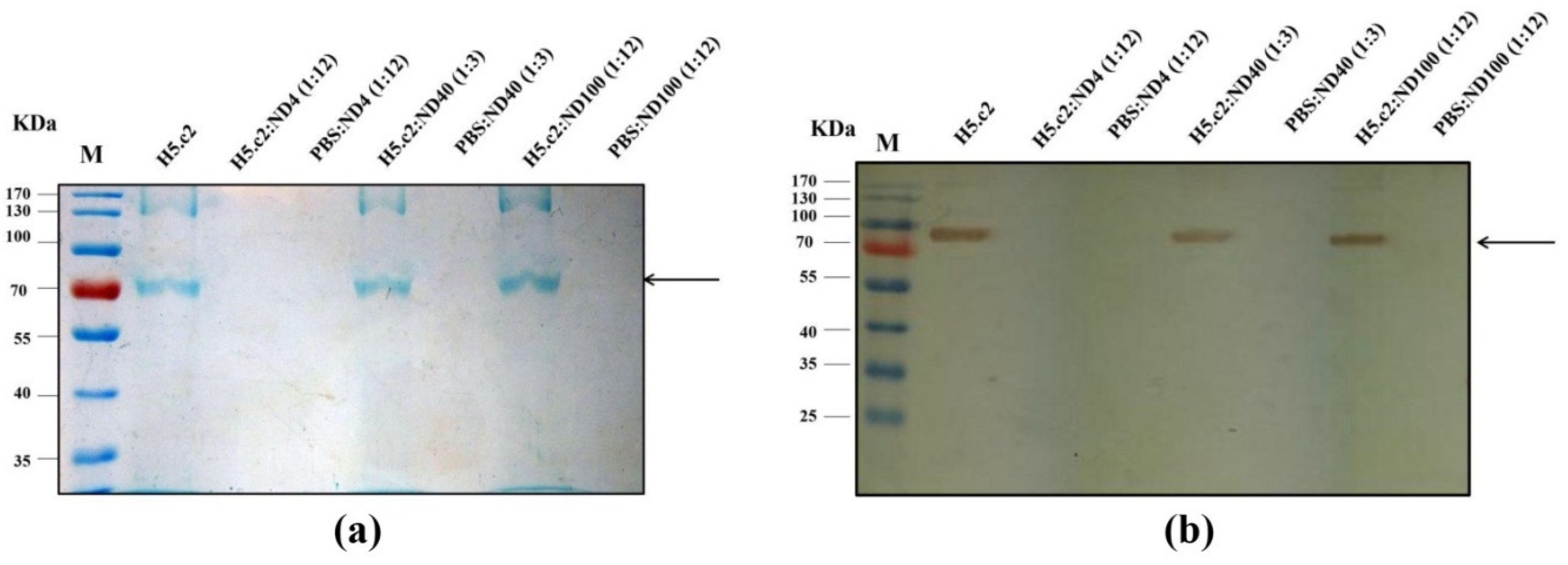
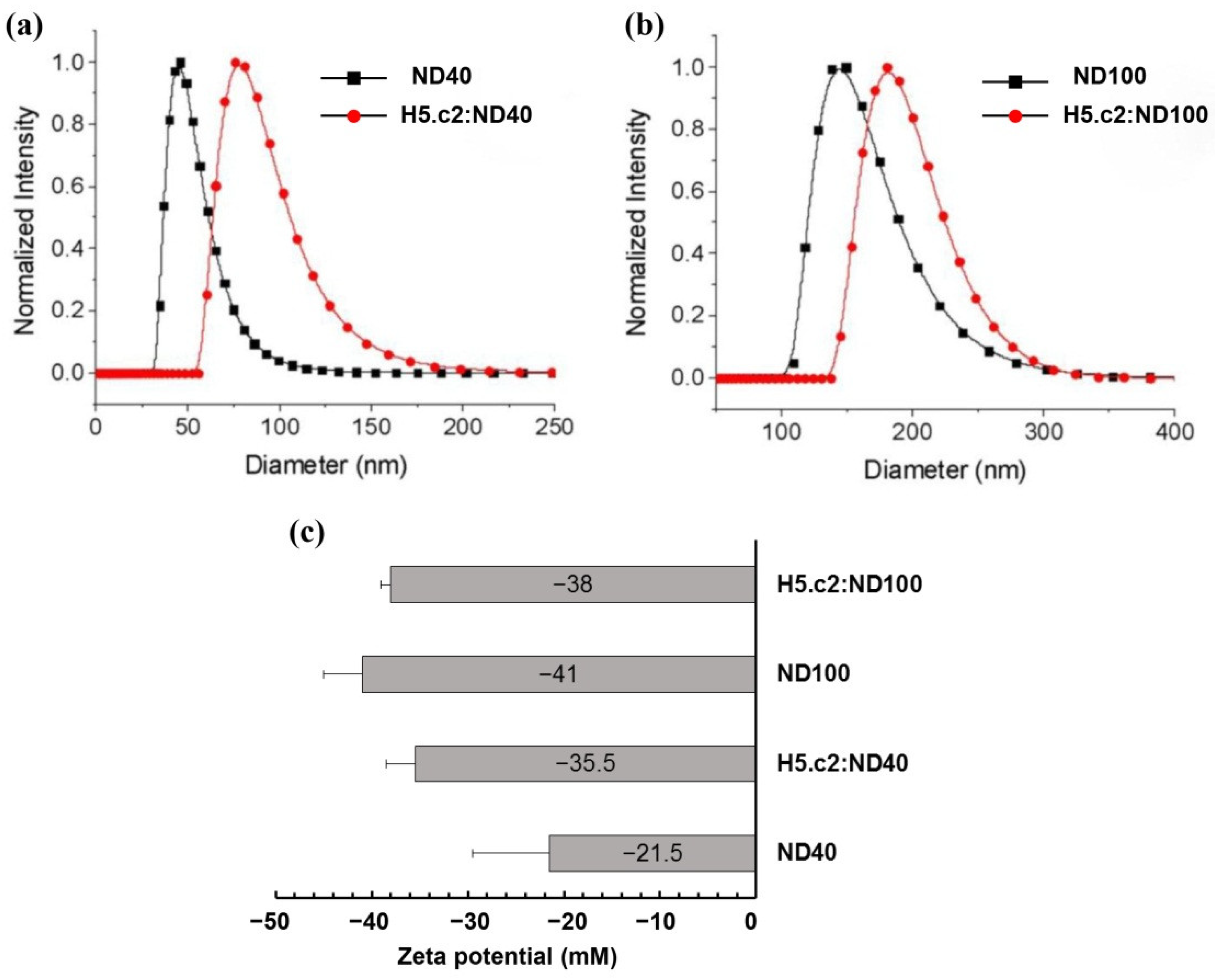
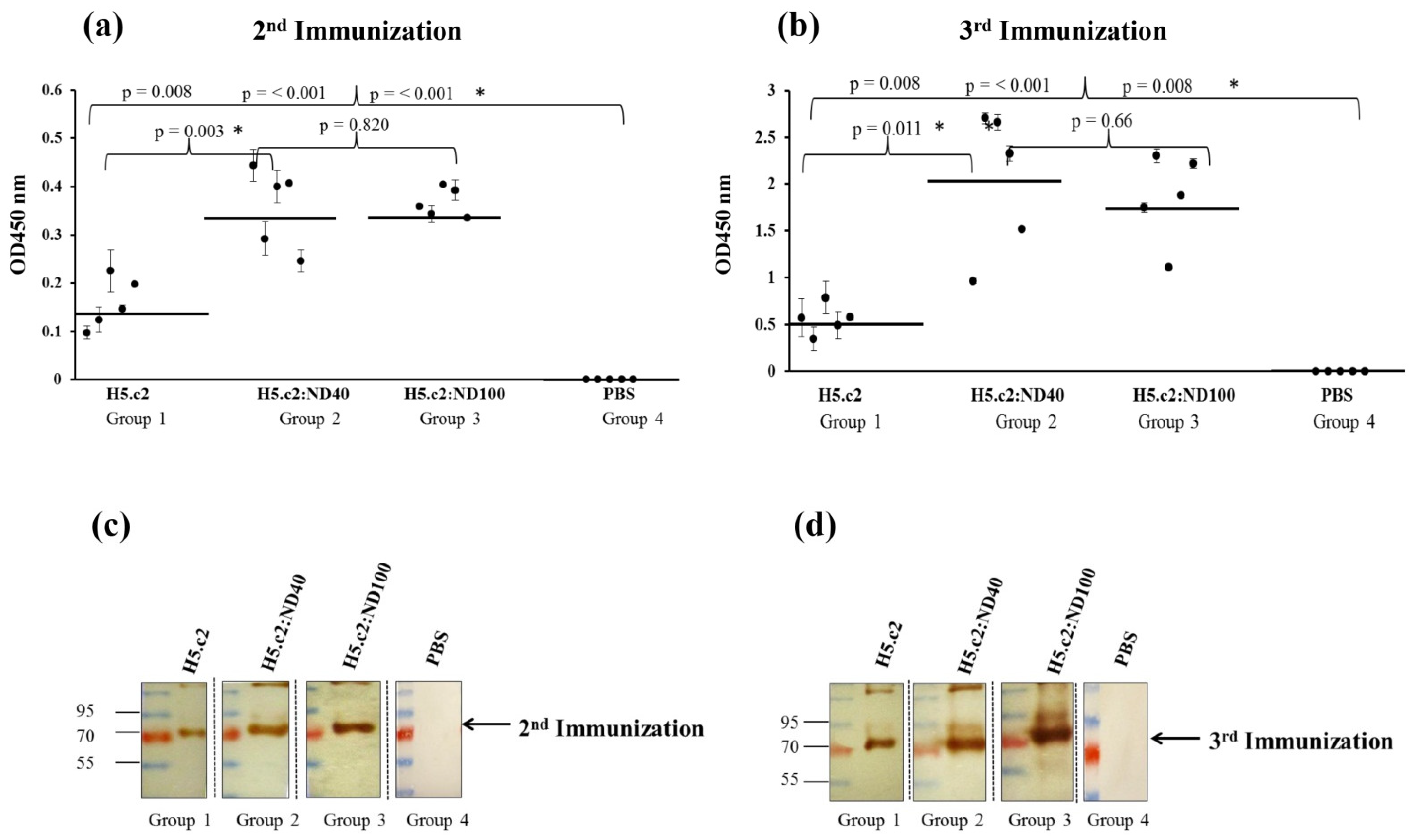
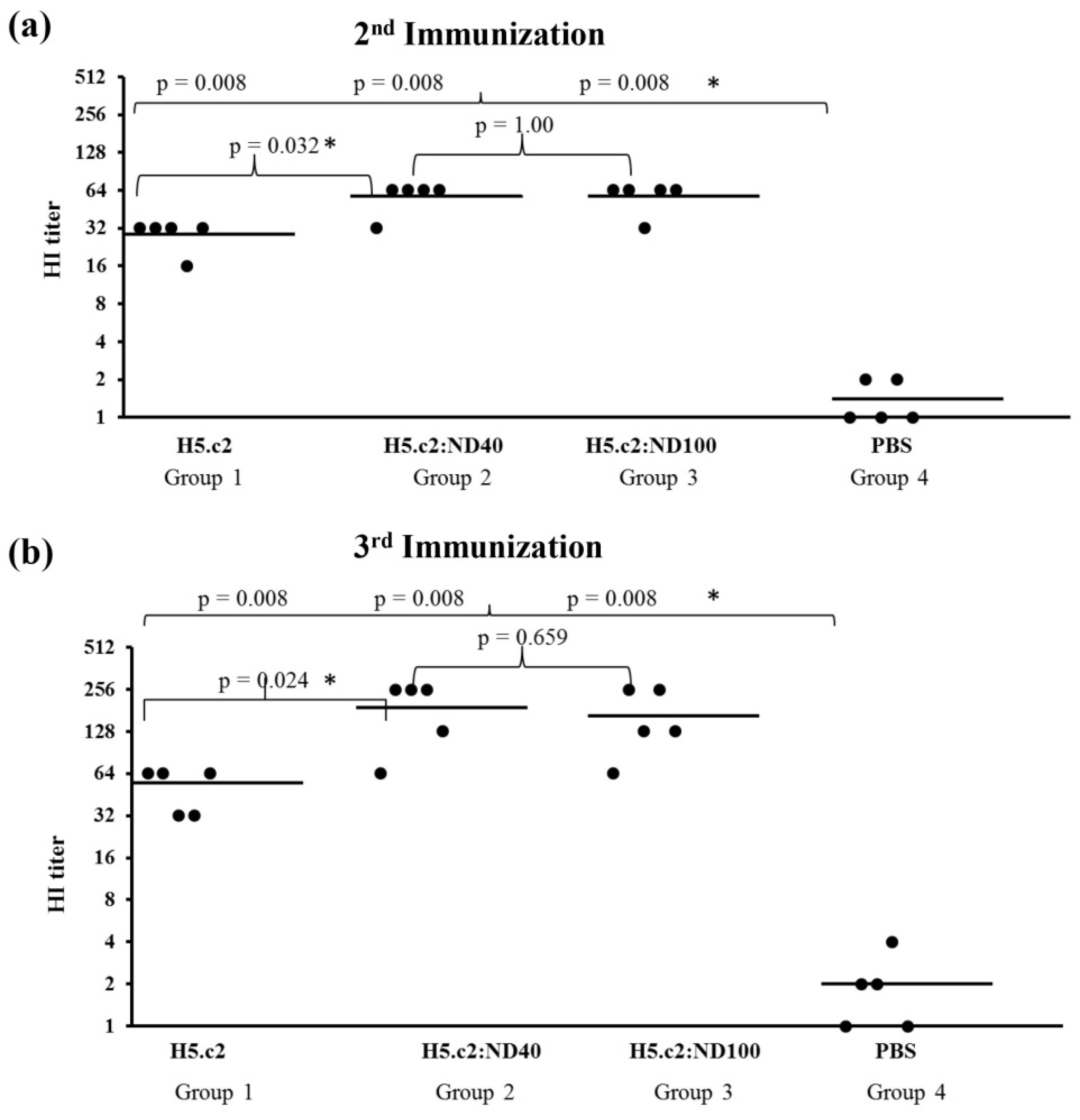
| Complex Samples | H5.c2:ND Ratio | HAU | Complex Controls | ND Ratio | HAU | HAU of H5.c2:ND after Subtract HAU of PBS:ND |
|---|---|---|---|---|---|---|
| H5.c2 | 1:0 | 4 | PBS | 0 | 0 | 4 |
| H5.c2:ND40 | 1:1 | 32 | PBS:ND40 | 1:1 | 0 | 32 |
| 1:3 | 128 | 1:3 | 2 | 64 | ||
| 1:6 | 128 | 1:6 | 4 | 32 | ||
| 1:12 | 128 | 1:12 | 4 | 32 | ||
| 1:24 | 64 | 1:24 | 4 | 16 | ||
| 1:48 | 8 | 1:48 | 8 | 0 | ||
| H5.c2:ND100 | 1:1 | 4 | PBS:ND100 | 1:1 | 0 | 4 |
| 1:3 | 8 | 1:3 | 2 | 4 | ||
| 1:6 | 32 | 1:6 | 2 | 16 | ||
| 1:12 | 128 | 1:12 | 2 | 64 | ||
| 1:24 | 64 | 1:24 | 4 | 16 | ||
| 1:48 | 64 | 1:48 | 8 | 8 | ||
| H5.c2:ND4 | 1:1 | 0 | PBS:ND4 | 1:1 | 0 | 0 |
| 1:3 | 2 | 1:3 | 2 | 0 | ||
| 1:6 | 4 | 1:6 | 4 | 0 | ||
| 1:12 | 16 | 1:12 | 16 | 0 | ||
| 1:24 | 16 | 1:24 | 16 | 0 | ||
| 1:48 | 16 | 1:48 | 16 | 0 |
Publisher’s Note: MDPI stays neutral with regard to jurisdictional claims in published maps and institutional affiliations. |
© 2021 by the authors. Licensee MDPI, Basel, Switzerland. This article is an open access article distributed under the terms and conditions of the Creative Commons Attribution (CC BY) license (https://creativecommons.org/licenses/by/4.0/).
Share and Cite
Ho, T.T.; Pham, V.T.; Nguyen, T.T.; Trinh, V.T.; Vi, T.; Lin, H.-H.; Nguyen, P.M.T.; Bui, H.T.; Pham, N.B.; Le, T.B.T.; et al. Effects of Size and Surface Properties of Nanodiamonds on the Immunogenicity of Plant-Based H5 Protein of A/H5N1 Virus in Mice. Nanomaterials 2021, 11, 1597. https://doi.org/10.3390/nano11061597
Ho TT, Pham VT, Nguyen TT, Trinh VT, Vi T, Lin H-H, Nguyen PMT, Bui HT, Pham NB, Le TBT, et al. Effects of Size and Surface Properties of Nanodiamonds on the Immunogenicity of Plant-Based H5 Protein of A/H5N1 Virus in Mice. Nanomaterials. 2021; 11(6):1597. https://doi.org/10.3390/nano11061597
Chicago/Turabian StyleHo, Thuong Thi, Van Thi Pham, Tra Thi Nguyen, Vy Thai Trinh, Tram Vi, Hsin-Hung Lin, Phuong Minh Thi Nguyen, Huyen Thi Bui, Ngoc Bich Pham, Thao Bich Thi Le, and et al. 2021. "Effects of Size and Surface Properties of Nanodiamonds on the Immunogenicity of Plant-Based H5 Protein of A/H5N1 Virus in Mice" Nanomaterials 11, no. 6: 1597. https://doi.org/10.3390/nano11061597
APA StyleHo, T. T., Pham, V. T., Nguyen, T. T., Trinh, V. T., Vi, T., Lin, H.-H., Nguyen, P. M. T., Bui, H. T., Pham, N. B., Le, T. B. T., Phan, C. V., Chang, H.-C., Hsiao, W. W.-W., Chu, H. H., & Pham, M. D. (2021). Effects of Size and Surface Properties of Nanodiamonds on the Immunogenicity of Plant-Based H5 Protein of A/H5N1 Virus in Mice. Nanomaterials, 11(6), 1597. https://doi.org/10.3390/nano11061597






